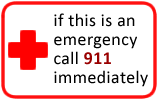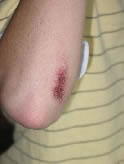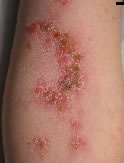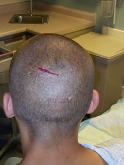Skin Injury (Cuts, Scrapes, Bruises)
Cuts, Scrapes, or Bruises (Skin Injury)
Does this describe your symptoms? |
Click image for more info |
Definition
When are Stitches Needed?
Liquid Skin Bandage for Minor Cuts and Scrapes:
What is Tetanus?
When does an Adult need a Tetanus Booster Shot?
|
If not, see these topics
First Aid:FIRST AID Advice for Bleeding: Apply direct pressure to the entire wound with a clean cloth. FIRST AID Advice for Severe Bleeding:
FIRST AID Advice for Penetrating Object: If penetrating object still in place, don't remove it (Reason: removal could increase bleeding). FIRST AID Advice for Shock: Lie down with feet elevated. FIRST AID Advice for Transport of an Amputated Finger or Toe:
|
When to Call Your Doctor |
Call 911 Now (you may need an ambulance) If |
|
|
|
Call Your Doctor Now (night or day) If |
|
|
|
Call Your Doctor Within 24 Hours (between 9 am and 4 pm) If |
|
|
|
Call Your Doctor During Weekday Office Hours If |
|
|
|
Self Care at Home If |
|
|
HOME CARE ADVICE FOR MINOR CUT, SCRAPE, OR BRUISE |
Treatment of Minor Cuts, Scratches and Scrapes (abrasions):
Apply direct pressure for 10 minutes to stop any bleeding.
Wash the wound with soap and water for 5 minutes.
Gently scrub out any dirt with a washcloth.
Cut off any pieces of dead loose skin using a fine scissors (cleaned with rubbing alcohol before and after use).
Apply an antibiotic ointment, covered by a Band-Aid or dressing. Change daily.
Another option is to use a Liquid Skin Bandage that only needs to be applied once. Avoid ointments with this.
Treatment of Minor Bruise:
Apply a cold pack or an ice bag wrapped in a towel for 20 minutes each hour for 4 consecutive hours (20 minutes of cold followed by 40 minutes of rest for 4 hours in a row).
48 hours after the injury, use local heat for 10 minutes 3 times each day to help reabsorb the blood.
Rest the injured part as much as possible for 48 hours.
Pain Medicines:
For pain relief, take acetaminophen, ibuprofen, or naproxen.
Acetaminophen (e.g., Tylenol):
Take 650 mg by mouth every 4-6 hours. Each Regular Strength Tylenol pill has 325 mg of acetaminophen.
Another choice is to take 1,000 mg every 8 hours. Each Extra Strength Tylenol pill has 500 mg of acetaminophen.
The most you should take each day is 3,000 mg.
Ibuprofen (e.g., Motrin, Advil):
Take 400 mg by mouth every 6 hours.
Another choice is to take 600 mg by mouth every 8 hours.
Use the lowest amount that makes your pain feel better.
Naproxen (e.g., Aleve):
Take 250-500 mg by mouth every 12 hours.
Use the lowest amount that makes your pain feel better.
Extra Notes:
Acetaminophen is thought to be safer than ibuprofen or naproxen in people over 65 years old. Acetaminophen is in many OTC and prescription medicines. It might be in more than one medicine that you are taking. You need to be careful and not take an overdose. An acetaminophen overdose can hurt the liver.
Caution: Do not take acetaminophen if you have liver disease.
Caution: Do not take ibuprofen or naproxen if you have stomach problems, kidney disease, are pregnant, or have been told by your doctor to avoid this type of medicine. Do not take ibuprofen or naproxen for more than 7 days without consulting your doctor.
Before taking any medicine, read all the instructions on the package
Expected Course: Pain and swelling usually begin to improve 2 or 3 days after an injury. Swelling is usually gone in 7 days. Pain may take 2 weeks to completely resolve.
Call Your Doctor If:
Looks infected (pus, redness, increasing tenderness)
Does not heal within 10 days
You become worse
And remember, contact your doctor if you develop any of the "Call Your Doctor" symptoms.
Updated:
March 22, 2017



















